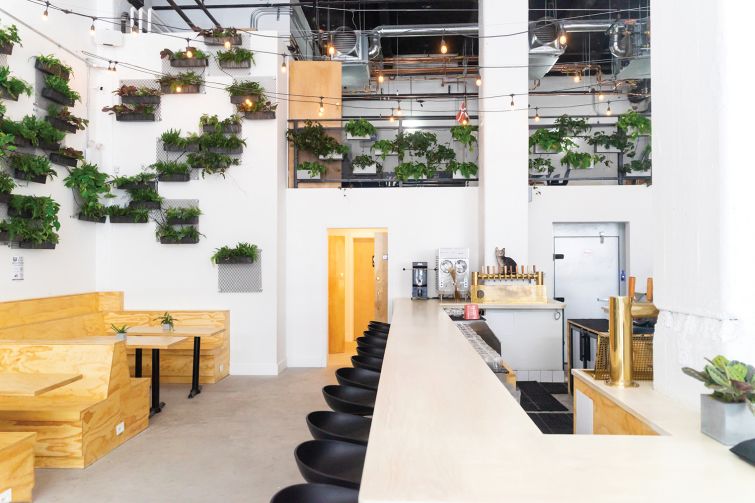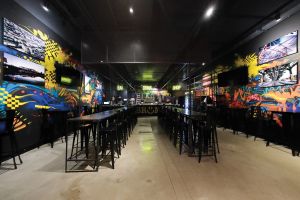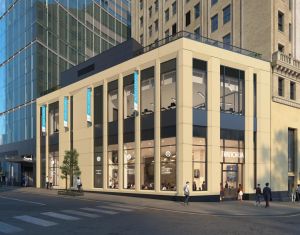The Best New Office Amenity? Beer Brewed Downstairs.
It wasn’t always easy finding space to sling suds in NYC, but more brewers are accepting the challenge — and some of the city’s top landlords want in on the action
By Nicholas Rizzi December 5, 2022 6:06 am
reprints
When Basil Lee and Kevin Stafford decided to take on their homebrew hobby as a full-time profession in New York, they expected it would take them a year to find a usable and, importantly, affordable space for their new venture, Finback Brewery. The city’s real estate market said otherwise.
“I was actually surprised at how difficult it was to find space,” Lee said. “We were shown spaces where the roof was caving in.”
The pair had hoped to find space in Gowanus, Brooklyn. But after a two-year search, Finback settled on 78-01 77th Avenue, an industrial space tucked at the end of a residential street in Glendale, Queens, a 30-minute walk from the nearest subway. The business opened in 2014.
Finback’s real estate struggles weren’t unique. Ever since craft brewing started its long fermentation to become a booming industry around the country, brewers have had to hunt around the outskirts of cities and industrial areas to find locations to set up shop. But all that has started to change. Beer is now a $100 billion industry, with about 27 percent of that coming from smaller craft breweries last year, according to the Brewers Association, a trade group.
In 2010, only three breweries were operating in New York City, but the city now boasts around 42 throughout every borough. Many have started to open second or third locations — not in industrial areas but at the base of office or luxury residential buildings.

And some landlords are actively seeking brewers to offer the ultimate amenity to some tenants: Beer brewed right downstairs.
“Beer brands are being placed in neighborhoods now,” said Tanner Scarr, the general manager of Ridgewood, Queens-based Evil Twin Brewing, which recently opened a second location at the base of Two Trees Development’s office property 45 Main Street in Brooklyn’s Dumbo neighborhood. “We’ve been reached out to, and they want us to be there.”
That’s a far cry from how things used to be. The pioneering New Amsterdam Brewing Company, one of the first to try to bring brewing back into the city in 1982 after beer making completely dried up in the 1970s, found a 110,000-square-foot warehouse on 610 West 26th Street for its brewpub. The area was then an undeveloped part of west Chelsea surrounded by a “couple of hundred prostitutes who worked the streets in the neighborhood and a lot of drug addicts roaming the street,” said founder Matthew Reich.
“It was an uphill battle to find a space,” Reich said. “Landlords absolutely didn’t know what to make of it. I needed to install millions of dollars worth of equipment and make a lot of capital improvements [and] modifications to the building. Most places were not interested.”
Brooklyn Brewery, which brought brewing back to Kings County after a 20-year pause, found an exposed brick warehouse at 79 North 11th Street in what was then a gritty part of the city: Williamsburg. In 2011, the Bronx Brewery opened at 856 East 136th Street in the South Bronx, where it had to demolish a second floor to fit equipment and dig new floors for drainage.
Now, when Finback was gearing up to open a Gowanus outpost at 545 President Street, the Durst Organization reached out to the brewery to see if it wanted to go for a third in its Sven residential development in Long Island City, Queens.
“We really see Finback as an amenity for the neighborhood, for the building,” said David Neil, principal at Durst who, along with Eric Engelhardt, had the idea to seek out a microbrewery for the Sven project. “We view retail as not only finding a company that’s going to pay rent but also going to enhance the neighborhood.”

Since 2019, Carroll Gardens-based Other Half Brewing took 3,600 square feet in Two Trees’ mixed-use Domino Sugar Factory redevelopment in Williamsburg; Evil Twin opened a 1,950-square-foot taproom at 45 Main in 2021; the Bronx Brewery debuted a third outpost in 1,400 square feet in Hudson Yards last month; Finback leased 3,800 square feet at the Sven in April; and Red Hook’s Sixpoint Brewing locked down 7,500 square feet for its second location in Brookfield Place.
And originator Brooklyn Brewery is getting in on the trend. Last month, it announced plans to leave its longtime Williamsburg home for a 41,000-square-foot space in the under-construction office, retail and industrial building 1 Wythe Avenue, just over the border in Greenpoint.
“Over the past decade, craft breweries have increased in popularity and their numbers have exploded across a variety of urban and rural settings,” Bart Watson, chief economist at the Brewers Association, said in an email to Commercial Observer. “Accordingly, it makes sense that some developments might look to craft brewers as ideal tenants for their buildings, both to attract foot traffic and as an amenity for tenants.”
A brewery could serve as a meeting point for tenants and a destination for visitors in the project, with the added benefit of bringing some local flavor to a large development.
“We wanted to build the community here and something that felt very authentic,” said Esty Ottensoser Hershfield, the director of leasing at Related Companies, about bringing in the Bronx Brewery to Hudson Yards. “They got local art on the wall and photography, they did a great job. It really does feel like their Lower East Side location.”
And, unlike bars, which studies have shown can lead to an increase in crime in neighborhoods, that isn’t the case with breweries. Breweries tend to have a more family-oriented vibe, and it’s not unusual to see a group with their children running around the space drinking next to a group of kids-free beer nerds.
“It’s not just a place to drink but it’s a place to bring your kids and bring your dogs, and so a lot of breweries have become this family-centered third place,” said Julie Wartell, a professor at the University of California, San Diego, who teaches a class on the impact of craft breweries to urban economics. “Whether it’s landlords or politicians, they see that this is attracting people and it’s not just a bunch of drunks, it’s something worthwhile to promote.”
As an added benefit for landlords, breweries also tend to get a lot of press when they announce new spaces. Durst was able to sign a lease with a tenant who only learned about Sven after reading a story about Finback’s lease. “The strategy is working,” Neil said.
For breweries, the extra locations mean more chances to sell beer directly to consumers, educating them personally on your suds, and putting another taproom within easier reach.
“With New York being as dense as it is, being in different areas is probably the easiest way to grow the direct-to-consumer product,” said Evil Twin’s Scarr, whose Ridgewood taproom is about a 40-minute subway ride from the Dumbo spot. “There’s 11 million people here now, and you’re trying to obtain as many eyes and ears on your product as possible.”
Evil Twin’s plan from the get-go when it dropped its nomadic brewing roots and set up more permanent digs at 1616 George Street in 2019 was to open taprooms in as many boroughs as possible. The company is currently eyeing spaces for a third in Manhattan.
It can also help them reach different demographics of people who might not want to trek to far-flung neighborhoods like Glendale or the South Bronx to visit the main locations.
“There’s not a ton of people just randomly finding themselves on the sidewalk walking around the South Bronx,” said Damian Brown, the co-founder of the Bronx Brewery, which also recently opened an East Village outpost. “The majority of people who come through Hudson Yards … odds are they wouldn’t be up necessarily to the South Bronx to visit us there.”
Opening other locations also helps control the quality of the beer served to customers — avoiding dirty tap lines at some bars, or beers that taste best after two weeks sitting around for three months before being served — and lets brewers get quick feedback from customers about their product.
“We don’t plan our beers out months in advance or years in advance, and that allows us to adapt to trends,” Scarr said. “And because of that direct-to-consumer, we could get feedback right away and adapt.”
And, in a space-constrained city like New York, it can allow brewers to expand the number of barrels they can produce, giving them the freedom to experiment while keeping their best sellers flowing at their main hubs. The Bronx Brewery has small brewing systems at both Hudson Yards and the East Village, and has already churned out 25 brews ranging from a Rye Saison with dill to a Golden Ale sold out of the latter since opening in February, Brown said.
Finback views its three locations as dedicated to different styles: Glendale focused on hazy IPAs, Gowanus on mild ales and lager, and Long Island City will be a “fruit-forward, interesting, unique fermentation kind of creative lab,” Lee said.

Evil Twin has opted out of dedicating brewing space at its outposts, which makes it a bit easier to find new locations since the brewer doesn’t have to worry about high ceilings or floors with drainage able to support the weight of fermentors needed in a brewery.
“Our first location was a full production facility, so we needed 6,000 square feet and lift gates,” Scarr said. “When we look at a space now that it’s just a taproom extension, we don’t have the same needs that [we had] when we were building a full-on brewery.”
What’s more, unlike before, landlords now actively want breweries in their projects, so they’ve been more willing to give rent breaks or work on partnership agreements with them to get deals signed. Since beer brewing can be an expensive industry to get into — with Scarr estimating it would cost at least $5 million to start one in the city now — that can be a huge relief.
“They were definitely helpful on rent,” Finback’s Lee said about Durst. “Our budgets are always going to be different than another type of tenant. … We’re just selling beer, we’re not doing something radically profitable.”
And those money constraints — paired with outdated New York state laws — are what held New York’s beer scene from returning in full force until the early 2010s.
The city had a thriving brewery industry in the 19th century, thanks to the influx of German immigrants who brought brewing traditions with them. At its peak, New York City had 121 breweries in the five boroughs and was home to the largest brewery in the country by the 1870s, Hell Gate Brewery in Yorkville. There were about 45 in Brooklyn alone, mostly concentrated in Williamsburg and Bushwick, The New York Times reported. Ridgewood, Evil Twin’s current home, was mainly developed to house brewery workers from neighboring Bushwick.
Then Prohibition came, which killed most breweries around the country. Despite trying to stage a comeback after Repeal in 1933, the city’s brewing industry dealt with a labor strike in 1949 that gave room for giants like Anheuser-Busch to swoop in and take over tap handles. Brooklyn’s last two breweries shuttered in 1976.
New York beer lovers were left in dark times suffering with Budweiser or Michelob dominating bars. That’s when Reich saw an opportunity, so he gave up his job as an executive at Hearst to start a brewery.
“I made a couple of batches of homebrew and I was really interested in getting into the alcohol business,” Reich said. “I fell in love with the flavors of British real ale and authentic German local beers, and I just thought there wasn’t much competition, so let’s build one.”
After the struggles of dealing with finding space, a state Liquor Board that had no idea what to do with him, and shipping a defunct brewery from Germany to Chelsea, Reich opened his taproom and restaurant to much fanfare in 1985. Mayor Ed Koch was on hand to pour the first pint.
New Amsterdam hung on until 1990 before the high costs of replacing equipment and pending debt payments forced Reich to sell it to a company that later shuttered the brewery. In the meantime, brands like Brooklyn Brewery, Harpoon and Samuel Adams opened, and the country’s beer renaissance started to foam.
The number of breweries in the country bottomed out at around 90 in the 1970s, but exploded in the 2000s to eventually hit 9,247 in 2021, according to data from the Brewers Association.
New York City was a bit slower to return, but all that changed when the state passed the Craft New York Act in 2014, which eased restrictions for operating breweries and distilleries. That led to a plucky group of beer lovers opening up spaces all around the city.
“When we started we had one beer, draft only, and no samples,” Bronx Brewery’s Brown said. “We self-distributed in an old Red Bull truck asking people in bars and restaurants if they wanted to buy a keg from us with a tap handle — that was kind of the sophistication of the industry.”
New York wasn’t alone in changing laws to make it easier for breweries to open. Wartell has found many others around the country eased zoning restrictions in an effort to support the industry since breweries can be a big boon to an urban neighborhood.
Once breweries open they drive more visitors and tourists to the neighborhood. New restaurants and shops often follow, and a brewery can be a key part to revitalize a struggling downtown.
“That has happened in almost every big city across the country, and even smaller cities and downtowns, that breweries have moved into commercial spaces and really just helped spur the growth,” Wartell said. “A lot of times what it is is bringing people to an area that … everybody would leave the downtown to go home [after work].
“There’s [also] a growing beer tourism that people are going out and spending a day visiting several breweries, and they’re going to places where they normally wouldn’t have gone if there weren’t breweries there,” Wartell added.
But that does come with some downsides as that economic boom can lead to more affluent residents moving in and longtime residents getting pushed out, Wartell said. However, she pointed to research from Portland, Ore., that found breweries usually coincide with gentrification rather than start it.
That could be a double-edged sword for some operators. While Brooklyn Brewery was a large part of the catalyst that turned Williamsburg from an industrial neighborhood to an artists hub and now an upscale enclave with a new Hermès store, it also led to them getting the boot from their North 11th Street home. After the building was sold in 2016, Brooklyn Brewery couldn’t get the lease renewed, leaving it searching for new, and cheaper, space before finally settling on 1 Wythe.
“When we moved to Williamsburg in 1991, spaces were practically being given away since the neighborhood was considered pretty sketchy,” Brooklyn Brewery CEO Eric Ottaway said in an email. “The ongoing commercial development of the area puts pressure on the ability of manufacturers like ourselves to remain in the area.”
And, even with more landlords reaching out, it’s still not an easy task to find the right space. These would-be breweries need high ceilings and floors that can handle a heavy load, and those retail spaces are also attractive to well-capitalized fitness tenants that have been gobbling up space around the city.
Add on the fact that the retail space often needs to fit in with the aesthetics of the brewery’s brand means that, even while fielding offers from landlords, leasing the perfect space can still be like finding a needle in a haystack.
“With a lot of these creative operators, it’s about getting into the space and making sure the space feels right,” said Ripco Real Estate’s Alex Beard, who’s brokered deals for Evil Twin and Other Half. “It’s all about how the space feels and what you’re trying to create and the vibe you’re trying to create.”
Nicholas Rizzi can be reached at nrizzi@commercialobserver.com.


